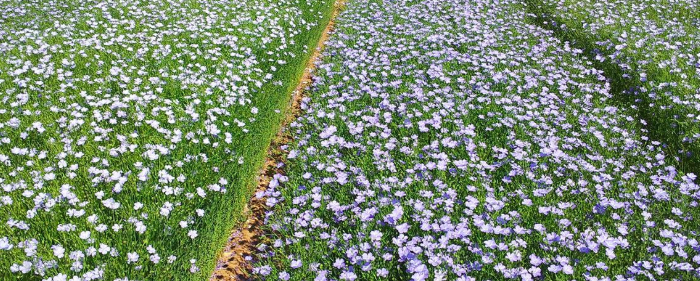
Varietal creation is born of men’s need to provide regular, abundant and diversified food. The adventure began about 10,000 years ago, and the evolution of techniques and knowledge has made it possible, in the twentieth century, to make exceptional qualitative and quantitative progress.
How are new varieties created?
A little history…
After being hunter-gatherers, men become neolithic farmers-farmers. Grouped into villages, they now produce their food, domesticating wild plants and adapting them to their needs. Power sources are thus more readily available.
They select and reseed interesting plants to grow . They favor those that are the most resistant, the most productive, the most nutritious, and which are transformed and preserved best. They seek both plants to feed, to heal and to dress.
The improvement of plants thus develops, empirically, for centuries , always with the prospect and promise of future harvests. The choice of seeds quickly becomes essential and changes the cultivated plants. Thus, the domestication of cereals has led to a selection of hard-edged plants and limited ginning (grain loss). The discovery of the sexuality of plants around 1700, then of genetics at the end of the nineteenth century (Mendel ‘s work), then that of the DNA molecule (1953), laid the scientific foundations for plant breeding.
The profession of coach
Today, plant improvement is at the heart of the business of the seed industry . It consists of creating new varieties from existing varieties by crossing together the selected plants for their respective qualities. Then the best plants from these crosses – the descendants – are selected until a plant with the desired qualities is obtained.
The knowledge and tools needed to obtain new varieties have led to the emergence of a new profession, that of breeder . The breeder makes the synthesis between the knowledge of plant biology and the observation of their behavior. Among the qualities expected at this post: patience … Indeed the creation of a new variety is very long: it requires up to 15 years of work.
The contribution of biotechnologies
While field trials and human expertise remain the basis of the breeder’s job , traditional breeding methods are now supplemented by biotechnologies that save valuable time.
For example, with biotechnology, it is now possible to have information on the genetic heritage of plants to anticipate the potential results of crossbreeding between parents . Specifically, the breeder has molecular markers that allow him to identify agronomic traits in the DNA of plants, concerning important aspects such as yield or disease resistance in particular.
Why create new varieties?
The varieties are never created randomly, but to meet the specific needs of interest to the farmer, processor (brewer, miller, semolina …) or consumer.
The expectations of the farmer
What counts for a farmer is that plants are best adapted to his soil and climate conditions. In the ocean zone, maize must withstand the wind. In Lorraine, wheat should not suffer from winter cold and in the south, crops must be able to withstand periods of drought and heat.
Plants for sustainable development
One of the first objectives of the selection of new varieties has been to increase yields, a necessary condition to meet the food needs of an ever-increasing population, and to ensure farmers’ incomes and the maintenance of their activities.
But this must not be done at the expense of the quality of the environment. Farmers need disease-resistant varieties that limit the use of plant protection products, fertilizer-saving varieties and soil-beneficial crops.
Meet specific needs
Food manufacturers produce flour, beer, pasta, oil … In order to obtain products of constant quality at the best price, they are looking for varieties that best meet the needs of farmers. intended use. They therefore need baking varieties for wheat, malting varieties for barley, sugar varieties for beet, varieties for making rapeseed or sunflower oil.
If plants play an irreplaceable role in the diet , they are also part of our living environment . Lawns, flowers and vegetables indeed find their place in the heart of collective spaces (parks, sports fields …) just as much as in the gardens of our houses.
They also contribute to our health , can be used in some household products (as solvents, lubricants, or surfactants) or as sources of energy, textile fibers, bioplastics or building materials.
For all these fields of application, it is necessary to adapt the plants by creating new varieties , then to produce the seeds for crops and quality crops.
Will the ideal variety ever exist?
Changing needs
New varieties frequently replace older varieties that no longer meet the needs of producers, processors, distributors and consumers. The needs of men are changing rapidly with changes in production and processing techniques, as well as patterns of distribution and consumption.
The fight against diseases is never won
The resistance of varieties to diseases changes over time. The more a variety is cultivated, the more its resistance is likely to be circumvented according to the case by diseases, fungi, parasites …
Protecting cereals against rust is as difficult as protecting men against the flu. At all times, laboratories are looking for new vaccines. At the plant level, it is the same for the breeder .
The vagaries of success
Each year, seed companies offer hundreds of new varieties but many do not grow commercially. On average, 9 new out of 10 remain very little used. Varieties will only have local development, depending on climate constraints and existing markets.
Search again …
Thus, given the diversity of soil and climate conditions, the ability of diseases to adapt, the evolution of technology, the diversification of products and the emergence of new outlets, there can be no to have ideal variety.
The search for new varieties is always very active and must constantly anticipate all the changes, years in advance.
Great article. Good to understand for everyone.